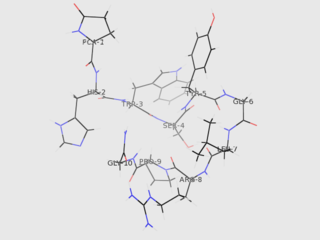Adrenocorticotropic hormone is a polypeptide tropic hormone produced by and secreted by the anterior pituitary gland. It is also used as a medication and diagnostic agent.

Pro-opiomelanocortin (POMC) is a precursor polypeptide with 241 amino acid residues. POMC is synthesized in the pituitary from the 285-amino-acid-long polypeptide precursor pre-pro-opiomelanocortin (pre-POMC), by the removal of a 44-amino-acid-long signal peptide sequence during translation.
Corticotropin-releasing factor, CRF is a family of related neuropeptides in vertebrates. This family includes corticotropin-releasing hormone, urotensin-I, urocortin, and sauvagine. The family can be grouped into 2 separate paralogous lineages, with urotensin-I, urocortin and sauvagine in one group and CRH forming the other group. Urocortin and sauvagine appear to represent orthologues of fish urotensin-I in mammals and amphibians, respectively. The peptides have a variety of physiological effects on stress and anxiety, vasoregulation, thermoregulation, growth and metabolism, metamorphosis and reproduction in various species, and are all released as prohormones.

Gonadotropin-releasing hormone (GnRH) is a releasing hormone responsible for the release of follicle-stimulating hormone (FSH) and luteinizing hormone (LH) from the anterior pituitary. GnRH is a tropic peptide hormone synthesized and released from GnRH neurons within the hypothalamus. The peptide belongs to gonadotropin-releasing hormone family. It constitutes the initial step in the hypothalamic–pituitary–gonadal axis.

Urocortin is a protein that in humans is encoded by the UCN gene. Urocortin belongs to the corticotropin-releasing factor (CRF) family of proteins which includes CRF, urotensin I, sauvagine, urocortin II and urocortin III. Urocortin is involved in the mammalian stress response, and regulates aspects of appetite and stress response.
Urocortin 2 (Ucn2) is an endogenous peptide in the corticotrophin-releasing factor (CRF) family.
Corticotropin-releasing hormone receptors (CRHRs), also known as corticotropin-releasing factor receptors (CRFRs) are a G protein-coupled receptor family that binds corticotropin-releasing hormone (CRH). There are two receptors in the family, designated as type 1 and 2, each encoded by a separate gene.
Growth hormone-binding protein (GHBP) is a soluble carrier protein for growth hormone (GH). The function of GHBP is still unknown. Current research suggests that the protein is associated with regulation of the GH supply in the circulatory system as well as GH receptor function.

Corticotropin-releasing hormone receptor 1 (CRHR1) is a protein, also known as CRF1, with the latter (CRF1) now being the IUPHAR-recommended name. In humans, CRF1 is encoded by the CRHR1 gene.

Thyroid hormone receptor alpha (TR-alpha) also known as nuclear receptor subfamily 1, group A, member 1 (NR1A1), is a nuclear receptor protein that in humans is encoded by the THRA gene.

Corticotropin-releasing factor-binding protein is a protein that in humans is encoded by the CRHBP gene. It belongs to corticotropin-releasing hormone binding protein family.

Urocortin-2 is a protein that in humans is encoded by the UCN2 gene.

Urocortin-3 is a protein that in humans is encoded by the UCN3 gene.

Antalarmin (CP-156,181) is a drug that acts as a CRH1 antagonist.
A Corticotropin-Releasing Hormone Antagonist is a specific type of receptor antagonist that blocks the receptor sites for Corticotropin-releasing hormone, also known as corticotropin-releasing factor (CRF), which synchronizes the behavioral, endocrine, autonomic, and immune responses to stress by controlling the hypothalamic-pituitary-adrenal axis. CRH Antagonists thereby block the consequent secretions of ACTH and cortisol due to stress, among other effects.
Astressin-B (AST) is a nonselective corticotropin releasing hormone antagonist that reduces the synthesis of ACTH and cortisol.

Verucerfont (GSK-561,679) is a drug developed by GlaxoSmithKline which acts as a CRF-1 antagonist. Corticotropin releasing factor (CRF), also known as Corticotropin releasing hormone, is an endogenous peptide hormone which is released in response to various triggers such as chronic stress, and activates the two corticotropin-releasing hormone receptors CRH-1 and CRH-2. This then triggers the release of corticotropin (ACTH), another hormone which is involved in the physiological response to stress.
Sauvagine is a protein that functions as a neuropeptide. It is 40 amino acids in length, and has sequence XGPPISIDLSLELLRKMIEIEKQEKEKQQAANNRLLLDTI-NH2, with a pyrrolidone carboxylic acid modification at the N-terminal and amidation of the C-terminal isoleucine residue. It was originally isolated from the skin of the frog Phyllomedusa sauvagei, but has been hypothesised to be produced endogenously by mammals, as it produces similar physiological effects to endogenous neuropeptides such as corticotropin-releasing hormone.

Emicerfont (GW-876,008) is a drug developed by GlaxoSmithKline which acts as a CRF-1 antagonist. Corticotropin releasing factor (CRF), also known as Corticotropin releasing hormone, is an endogenous peptide hormone which is released in response to various triggers such as chronic stress, and activates the two corticotropin-releasing hormone receptors: CRF1 and CRF2. This then triggers the release of corticotropin (ACTH), another hormone which is involved in the physiological response to stress.






















